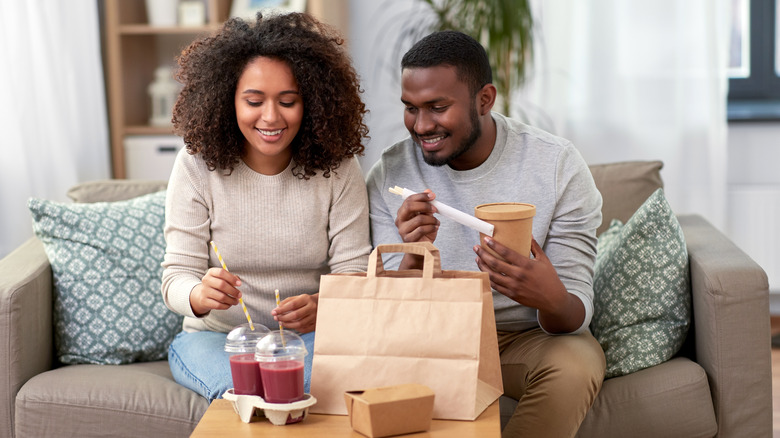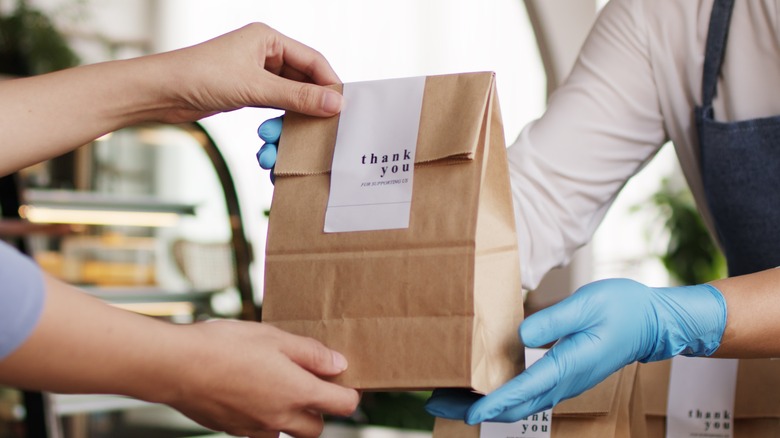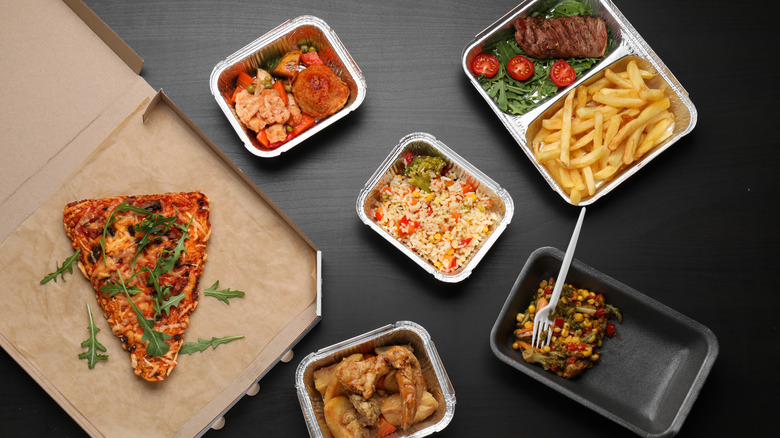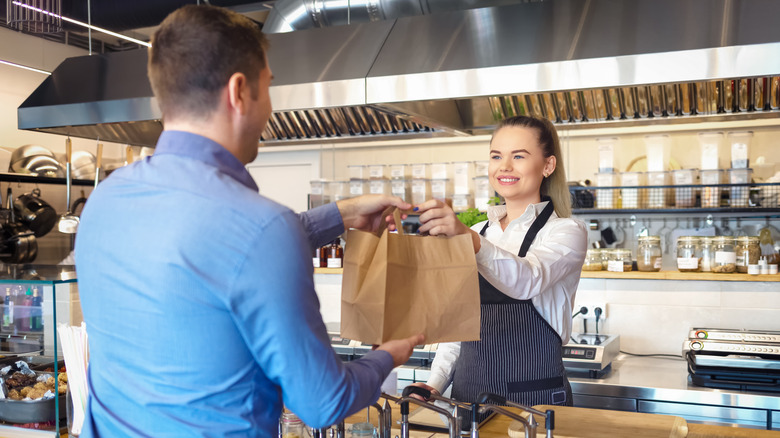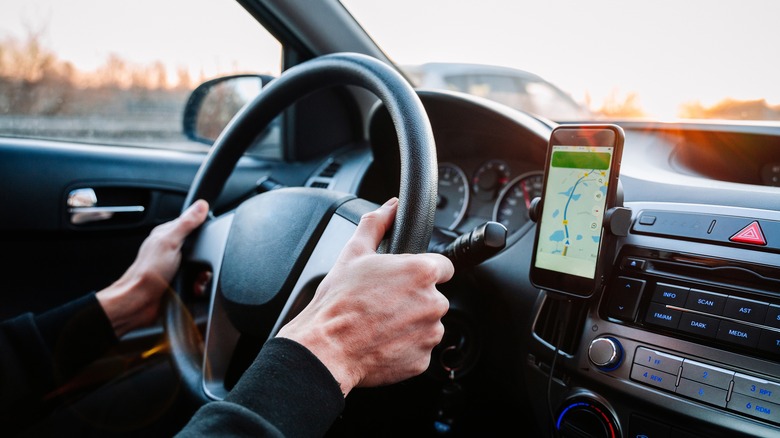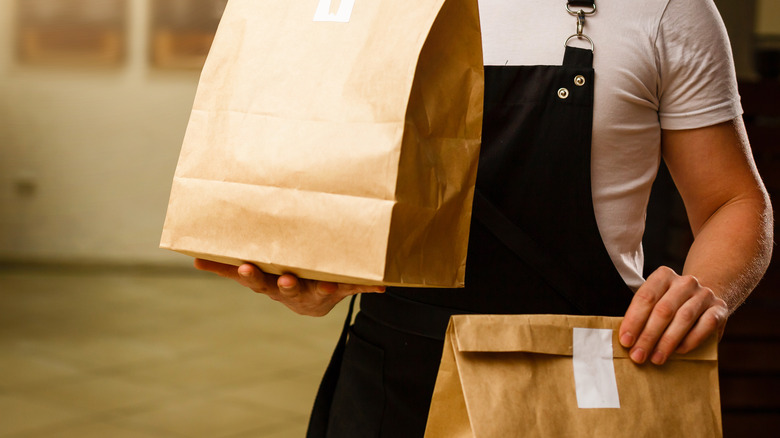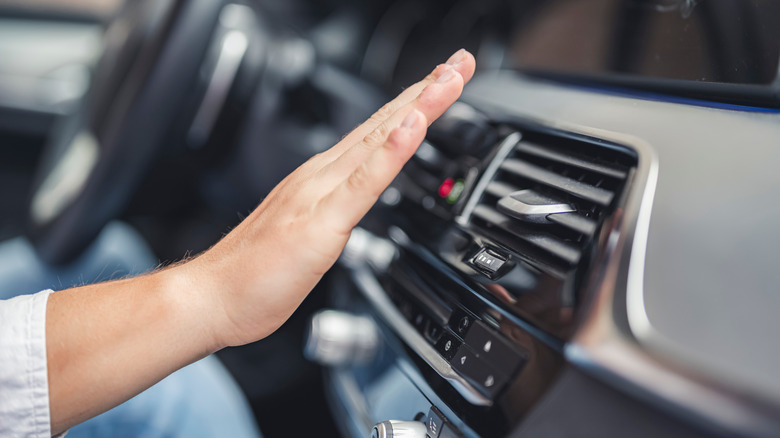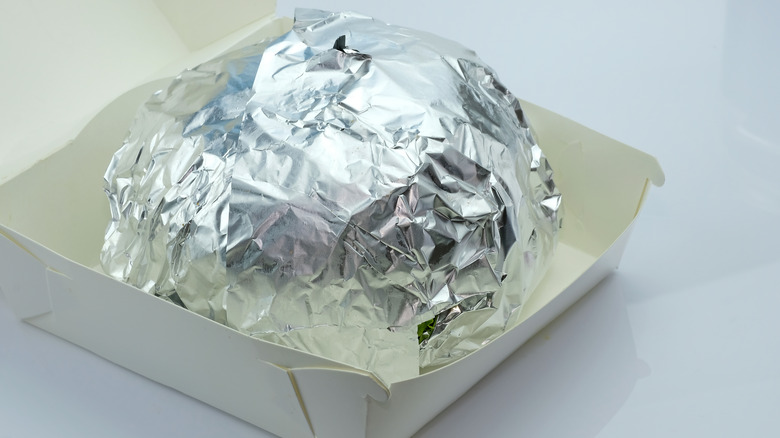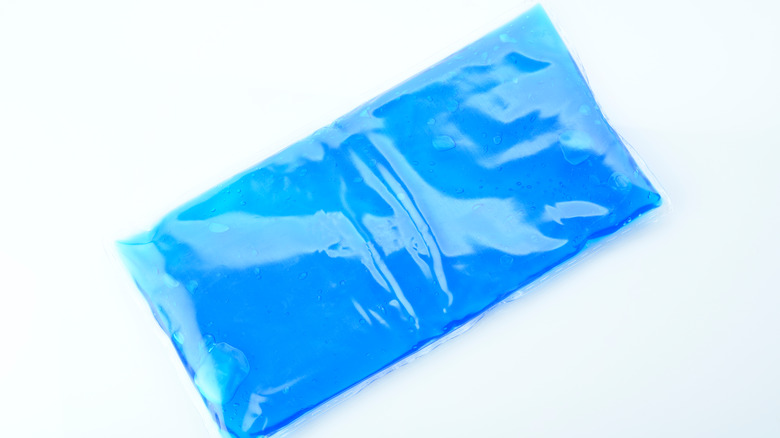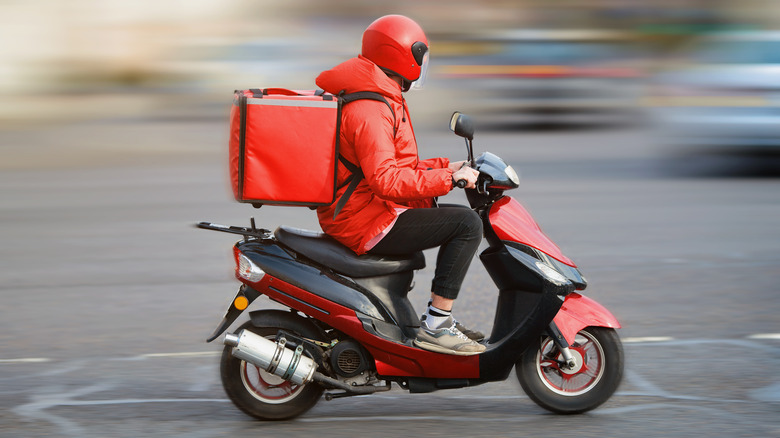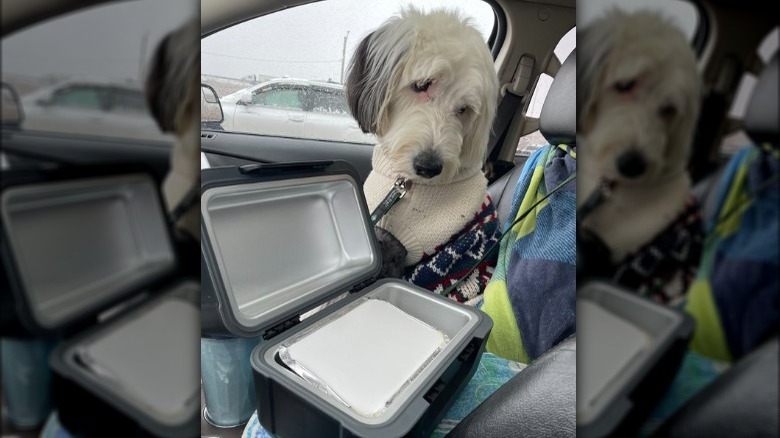12 Takeout Tips For People Who Hate Cold Food By The Time They Get Home
We may receive a commission on purchases made from links.
Not too many people like eating cold takeout food. You hope that everything in your to-go bag will stay perfectly warm and fresh while you travel the miles to get home. Unfortunately, our food often arrives home cold, limp, and soggy. With the prices of food at restaurants climbing steadily higher, ending up with subpar food that has degraded on the ride home is even more disappointing than ever.
Luckily, there are some things you can do to ensure you get your order as quickly as possible after it leaves the kitchen and to ensure it stays warm on the way home. There's a right and wrong way to order, a better way to get home, and ways you can store your food to ensure it's as warm as possible when you get home – even if you live a long way away or traffic is unexpectedly bad. When used together, these tips will make you more likely to enjoy your meal warm and exactly how it was meant to taste.
Don't use a delivery app to order
Back in the Stone Age before everyone used delivery apps, we used to call local restaurants to order takeout or delivery over the phone. Remember that? Newsflash: most restaurants still allow you to order pickup and sometimes even delivery over the phone. Talking to a real human can give you a better idea of how long to expect them to complete your order. So, if you know they're not busy and can get your order done right away instead of in 30 minutes, it won't be sitting there on the counter getting cold, waiting for you to arrive. If it will take them less time to prepare the dish than it will take for you to arrive, you can even ask them to wait to make it to correspond with your arrival time.
Of course, this strategy won't necessarily work for chain restaurants that use an operator on the other side of the country (or globe) to send your order to the restaurant. However, it certainly works well for local restaurants like your favorite Mexican spot down the street. Plus, the restaurant will appreciate you giving them a call or ordering directly from their website rather than using a delivery app so that they don't lose a percentage of the sale to delivery company fees.
Pick it up yourself instead of waiting for a delivery driver to bring it to you
If you want your food to arrive hot, third-party delivery isn't always reliable enough. Did you know that DoorDash actually allows 30 minutes for a driver to pick up your order? How many times have you or your friends gotten increasingly angry because your Chinese takeout is sitting on a counter waiting for a delivery driver to finally decide it's worth their time? Your food grows colder, limper, and more unappetizing as you wait. For the amount of time you have to wait, you could have already traveled to the restaurant and back twice and eaten. Who wants their food sitting around getting cold for half an hour before it even begins its transit through traffic?
There are a few factors to consider when determining if delivery is a good idea for getting your food to you while it's still warm. First of all, the farther you live from the city's busiest areas, the less likely a driver will be available when your food is ready. Secondly, ordering during peak hours can mean that available drivers are already swamped with other orders. Thirdly, if your order is small, the tip won't be worth the driver's time unless you beef it up a bit. So, especially if you live on the edge of town, want to order during peak times, and have a small order, you might be better off picking the food up from the restaurant yourself.
Order from restaurants that use good packaging
Pay attention to the type of packaging that restaurants use for takeout. To be more environmentally friendly, several states and cities in the U.S. have banned restaurants from packaging their takeout in styrofoam or polystyrene containers. As a result, restaurants have had to make different choices to package takeout food. The truth is that some don't really concern themselves much with food temperature. So, you're likely to get your takeout food in containers that won't keep your food warm, like paper wrappers or plastic containers. However, there are some restaurants that go the extra mile to ensure your food gets to your home warm so that you're happier with your meal and don't have to reheat it upon arrival.
Restaurants concerned about keeping food warm will often use aluminum foil for burritos, foil-lined bags for burgers, or foil containers with lids for items like pasta or rice dishes. Pizza restaurants have been successful for years with keeping pizza piping hot in robust cardboard boxes. Once you take note of the packaging type your favorite restaurants use, you can better judge which ones will make it to your home warm and which won't. Then, plan accordingly.
Order from places close to home
You should consider distance whether you're ordering pickup or delivery if you want warm food.If you want to make sure that your food is still warm when you get it home, choose restaurants that are close by. That fish-n-chips drive-through on the edge of your neighborhood or that Mexican restaurant around the block will be your best choice for getting your food home while it's still hot. If you don't want to dine in or picnic with your food, but still want to eat your food while it's hot, you should order from a nearby Thai restaurant rather than one in a downtown area notorious for traffic snarls.
According to the USDA, you want to be careful that your food doesn't stay in the "danger zone" for too long. So, if there's any chance your food temperature would drop to temperatures between 40 and 140 degrees Fahrenheit for over two hours, there's a higher risk of it becoming overrun by harmful bacteria that can make you sick. And if you're transporting your food by bike or in a car without air conditioning on a warm day above 90 degrees Fahrenheit, the countdown to when your food will become overrun by bacteria is only one-hour instead of two.
Use real-time traffic technology to optimize your route home
Yes, you probably know how to get home from your favorite restaurant, but there's always the chance that the route you always go isn't the quickest. So, if you're concerned with keeping your food the warmest possible during transit, you'll want to use GPS technology that offers real-time traffic updates when routing you home.
Is there a wreck on the highway you didn't know about? Is it gameday in a college town with all the main streets backed up for miles? If you use a GPS program that knows these things every time you drive home from picking up carryout, you'll be more likely to be able to avoid traffic surprises. Of course, your GPS or app may shunt you through windy-twisty roads you never knew existed, but you're more likely to get to eat your kung pao chicken in front of your latest binge-able tv series instead of sitting on the interstate waiting for a wreck cleanup.
A 2009 NuStats study showed that drivers using real-time traffic GPS technology had an 18% shorter trip than those who didn't (via Autoblog). So, if your vehicle doesn't come equipped with a GPS service that routes you away from traffic snarls, you will want to consider using an app like Google Maps to make your drive home more efficient and keep your food warm.
Separate your hot and cold foods
Most of us immediately separate our cold drinks or milkshakes from the rest of our food. However, we can sometimes forget about other cold foods that might be in our order. For example, if you ordered a salad, coleslaw, or cheesecake alongside your order of fried chicken and meatloaf, separating all your cold foods from your warm foods is essential. Without separation, your cold foods will get warm and your warm foods will cool off more than you want. If you're lucky, the restaurant may have already done this for you, placing warm and cool foods in separate bags. Although, you'll still need to take the extra step of separating the bags so that they're not touching each other.
Heat energy transfers from higher-temperature items to lower-temperature items, so heat not only transfers from your food to the cooler air around it but also from your food to any cooler food that it touches. When hot and cold foods touch, the heat transfers to the cold food via conduction. So, not only is your hot food becoming cooler, your cold food is becoming warmer.
Pay attention to your vehicle's climate
While keeping ourselves cool in our hot car, we sometimes forget that we're also cooling down our food. So, if it's warm weather and you're running your air conditioner, you want to pay special attention to where you're storing your food on the journey home. If it's too hot to ride with the windows rolled down, you'll want to place the food in an area that is not in direct contact with air from the air conditioning vents. Probably the easiest spot for this is in the floorboard of the car, while only activating your top vents and pointing them away from your food.
In the winter, your food will still lose heat to the air around it, but at least you won't be blasting cold air onto your food and speeding up the process. However, you don't want the inside of your car to be too hot in either winter or summer. If you end up raising the temperature of the inside of your car to 90 degrees Fahrenheit or more, you will speed up how quickly any bad bacteria in your food will multiply, making it potentially more dangerous to eat within only an hour.
Wrap your food in foil
If the restaurant you're getting your food from doesn't use containers with good insulation or you're not sure if they do or not, it's a good idea to take a box of foil along with you to retrieve your food. When you wrap your food or food containers in foil, the reflective surface will help keep the heat in and keep your food warmer longer. As your food produces heat inside of the foil packet, the foil will reflect the heat back to the food.
There are a few tricks you should use to maximize how much heat your food retains inside the foil packaging. When you start to wrap your food, take special notice of which side of the foil you place next to the food. You want to have the duller side facing outside and the shinier side facing inward. Foil alone can do the trick over a fairly short distance. Since foil is a good heat conductor, you should also ensure that it doesn't actually touch your food. If it does, it will transfer the heat you want to preserve into anything the foil touches, including the air outside the foil packet. If you want to make double sure that your food remains as hot as possible, we suggest adding a secondary layer of cloth, plastic wrap, or placing it inside a plastic ziplock bag. Combining both foil and plastic will help you keep your food at a satisfactorily warm temperature for over 30 minutes.
Surround your food with heat packs
You can use heat packs to help keep your food warm inside of a bag or box while you take it home. If you're often transporting food between a restaurant and home, you might want to invest in resuable heat packs. You'll find that heat packs work even better if you're transporting your food in a metal container or if your food is covered in foil. Simply place the heat pack inside the container or touching the outside of the foil.
You can purchase ready-made heating packs like Pyrex gel-filled heat packs and place them around your food to help keep it warm while you travel home. If you don't want to purchase a heating pack, you can always make your own from items you probably already have lying around the house. For a temporary one, simply add a damp hand towel to a ziplock bag and microwave it until warm. The towel can help to keep your food warm while you get it from the restaurant to your house. If you want to make a more permanent reusable food heat pack, all you need is an old sock and some uncooked rice or oats. Simply fill the sock with the rice or oats and either tie the end in a knot (easier if you're using long socks) or sew the opening closed. Then, you can microwave it to make the pack hot and place it alongside your food during transport.
Use an insulated bag or box for transport
If you want to up your food transportation game, you should take your cues from your favorite pizza delivery restaurant. If your food is cold by the time it arrives, they know their customers won't be happy. So, you'll notice that they not only place their pizzas into thick cardboard boxes, but they also place the boxes inside well-insulated boxes or bags. Using insulated containers is one way that pizza and other food delivery drivers keep your food as warm as possible on their way to your home.
You probably knew that ice chests can keep food cold. However, did you know that you can also use them to keep food warm? When you put your takeout food into a the typical insulated ice chest or food cooler, some are capable of keeping your food toasty warm and safe to eat for 4 to 6 hours. So, if you have a long distance to travel, using an ice chest can be a great transport option. You could even bring food home from another city. Of course, you still have to be careful that your food doesn't reach the "danger zone" between 40 and 140 degrees Fahrenheit for over two hours. So, it can be helpful to wrap the food in foil, add heat packs to the box or bag, and check your food temperature before eating.
If you decide to try an insulated bag instead, you may want to pay attention to the bag's material. Nylon bags allow excess moisture to escape so you don't end up with soggy food. Meanwhile, vinyl bags don't allow moisture to escape and can result in excess condensation inside the container.
Invest in a portable food warmer
If you're serious about keeping your food warm between your favorite restaurants and home, you may want to invest in a portable food warmer. You'll just want to be sure you understand what you're getting before you buy one. You might see portable food warmers also called electric lunch boxes. You'll also want to make sure it's big enough for a variety of container sizes and that it's also compatible with everything from plastic to foil containers.
Most portable food warmers plug into your cigarette lighter, so they can use the power from your car to keep your food warm for you. Since many of the food heating and warming devices on the market are geared toward people with an RV, you will want to ensure that the food warmer runs on 12V power. If you get one that runs on 110V AC, you'll have to buy a power inverter to make it work. Keep in mind that you can end up draining your battery if you keep your food warmer plugged in and powered on after turning off your car. Some food warmers also require upgrading to a high-output alternator under the hood to prevent battery draining — so you may want to avoid those types as well.
Consider not taking it home
Some foods are never going to make it home with the right flavor and texture as they had the few minutes after leaving the kitchen. Your fries are going to get limp, your nachos are going to get soggy, and condensation is going to make your hot sandwich wet. Yet, more and more restaurants (especially fast food restaurants) are going to drive-through-only models. So, rather than driving home, why not eat it before you get home? We don't mean you should drive with a burger in one hand. Instead, consider eating parked in your car or going on a picnic.
There's even a whole line of products geared toward eating meals in a parked car. For example, you can purchase a steering wheel tray, which even has an indention to hold your drink while you eat. There's even a sauce holder you can clip to your vent to make dipping nuggets and fries even easier. Just be sure not to turn on the air conditioner while you're using it unless you relish the idea of a ranch-scented car.
If you don't want to deal with your car smelling like curry for a few days and clumsy spills, consider taking your food for a picnic instead. Just look on your favorite map app to locate the nearest park, and you can simply dine outside. In the event that the park doesn't have picnic tables, don't forget to pack a blanket to put on the ground.
